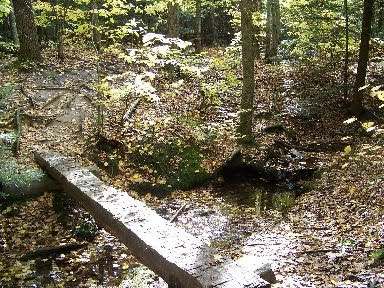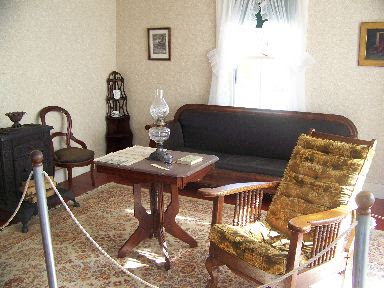With October zipping right along (and November breathing down my neck) I was feeling both excited and a little sad to be launching my final field trip for the fall. This time I enlisted my nephew Keith as traveling buddy. We had been talking about going for a hike, so that part worked. And he was a history major in college, so he “got” the house visiting part of the plan. And he’s always good company.
The unappealing thing about western Massachusetts for me is simply that I have to endure a long (usually boring) drive to get there. The good thing about this day was that, unlike the day of the Lenox expedition, it wasn’t raining. So the ride was just boring, not boring and dreary.
Arrowhead, Herman Melville’s home in Pittsfield, is now home to the Berkshire Historical Society. We bought our tour tickets and poked around the store in the small building at the back of the house and, on the recommendation of the cashier, walked through the exhibits in the barn. A series of captioned photos explained the history of the house—2009 is the Arrowhead’s 225th anniversary—and its restoration. Another exhibit shows a collection of colonial era furniture and tools.
We lucked out and got a tour to ourselves (advantage of visiting on a weekday, I guess). Our tour guide, a retired high school history teacher, had plenty to tell us about the house and its contents—when she learned that we were most interested in Melville, she focused mainly on his part in the building’s history. She started on the piazza (a reconstruction of the one that existed in Melville’s time, because a subsequent owner tore down the original), Melville’s favorite spot in the house. The view from the porch is topped off by Mount Greylock in the distance, rising above the trees.
Melville described the wonder of this view in “The Piazza”:
“Whoever built the house, he builded better than he knew; or else Orion in the zenith flashed down his Damocles’ sword to him some starry night, and said, ‘Build there.’ For how, otherwise, could it have entered the builder’s mind, that, upon the clearing being made, such a purple prospect would be his?—nothing less than Greylock, with all his hills about him, like Charlemagne among his peers.”
Melville, born Herman Melvill in 1819, had a childhood of privilege in New York City. But in 1830 his father, a merchant, went bankrupt and the family moved to Albany. Two years later his father died, leaving his mother a widow with eight children. Herman and his older brother had to work to help support the family. One of his jobs was helping on his uncle’s farm in Pittsfield. Melville (his mother added an “e” to the name after her husband’s death—was it to try to avoid creditors or a symbolic separation?) visited the area almost every year until he bought Arrowhead.
He worked at a variety of jobs: first as a clerk and bookkeeper, then as a schoolteacher (after managing to get some schooling of his own). In 1841 he sailed on the whaler Acushnet as a member of the crew but deserted in the Marquesas Islands in the South Pacific. He crewed on a few other ships and made his way back to Honolulu, where he enlisted in the US Navy. He returned to Boston in 1844 and was discharged.
Melville jumped at the “write about what you know” idea and produced a book (eventually titled Typee) based on his experiences in the Marquesas. His brother, Gansevoort, helped him sell it to a London publisher and it was released in 1846. A short time later a New York company also published the book. Melville followed up with four more novels in the next four years, all based on his sea travels.
In 1850 while visiting Pittsfield with his wife Elizabeth and toddler son Malcolm, Melville was part of a picnic outing to nearby Monument Mountain that included James T. Fields (our friend from Ticknor and Fields publishing house) and his wife Annie, Oliver Wendell Holmes and Nathaniel and Sophia Hawthorne. Seems we’re right back where we started: Everyone, it seemed, knew everyone.
Melville and Hawthorne met on this outing and enjoyed a close friendship for the next several years. The Hawthornes were living in Lenox at the time, and Melville thought he’s settle in the area as well. He bought the 160-acre farm known as Arrowhead, which abutted his uncle’s farm. His father-in-law, Lemuel Shaw (Chief Justice of the Massachusetts Supreme Court), provided half the money for the purchase.
The family that moved into the new home consisted of Melville, wife Elizabeth and son Malcolm as well as Melville’s mother and three of his sisters. During their thirteen years here, the Melvilles welcomed three more children.
It was obviously a bustling place, but Melville would shut himself away from the commotion in his second-floor study (with a beautiful view of Mount Greylock), where he produced among other works, his epic Moby-Dick. He dedicated the book to Hawthorne, who had talked with him about the story’s potential to be something deeper than a swashbuckling sea story.
At Arrowhead Melville’s sister Augusta, known as “Gus,” helped her brother as copyist, making clean copies of his manuscripts to send to his publisher. Producing those clean copies may have been efficient for business, but it means that there are few specimens of Melville’s manuscripts in his own handwriting.
He followed Moby-Dick with another novel, Pierre (1852). Neither enjoyed the popularity of his earlier works, and Melville fell into a depression. His father-in-law sent him on a European trip in an attempt to bring him out of his funk, while Elizabeth and the children stayed with the Shaws in Boston.
Melville struggled as an author and couldn’t make a good living at it. In 1863 he traded Arrowhead to his brother Allan for Allan’s house in New York City. A couple of years later he secured a position in the custom house at the port of New York. By the 1880s Melville had sunk into obscurity. When he died in 1891, he left behind a number of poems and sketches and the manuscript of Billy Budd, written in his own hand. (Billy Budd wasn’t published until 1924.)
We left Arrowhead and drove to Stockbridge for a quick bite. Elm Street Market was a great place to get it. We could have laid in supplies—appropriate trail food and drink—but we opted to stop for a bit to enjoy our lunch at the counter and watch the grill cook in action. We lucked out and grabbed a couple of stools and placed our orders before the riders of a tour bus walked in.
The cook turned around sandwich orders with entertaining speed and efficiency. By the time the flurry was over our lunch was sitting before us: grilled hot dogs (listed as Chicopee franks on the menu) that popped in a satisfying way under pressure of teeth—it’s a simple pleasure. We helped ourselves to drinks from the cooler, then ate and eavesdropped (you can always tell a “regular”), and when we were finished we told the cashier what we had eaten and settled up the bill. All refreshingly low key.
Fueled up and ready for more adventure, we headed down the road to Monument Mountain in Great Barrington. As the story goes Melville and Hawthorne, deep in conversation, took shelter under an overhanging rock and continued their talk until the rain abated.
We had no rain to worry about—the day was crisp and clear, a perfect autumn specimen. The area, a property of the Trustees of Reservations, is a popular area for hikers. On the Wednesday afternoon we visited we passed probably ten other parties—couples, folks with dogs, families. The various trail choices make it a doable hike for most anybody. We did a nice loop that took us to the summit.
There were several good spots for getting the wide view—the westward-looking one provided a vista of red and gold trees that looked like a patchwork quilt that just wouldn’t translate through the camera. Some things have to be seen to be appreciated.
By plan, the steeper trail was our descent. The trails are well maintained and included a few cool bridges across a stream.
I kept my eyes open for a rocky overhang that looked like it could be a writers’ refuge. I imagined Melville and Hawthorne crouched in the shadows, carrying on their lively conversation during the rainstorm. It was their first meeting, so there had to have been at least a little getting-to-know-you conversation. Maybe they talked about how they both added letters to their last names. You did? Yeah! Me, too!
Keith and I didn’t have any deep literary conversation, but we did discuss the optimal construction of a peanut butter and jelly sandwich.



















